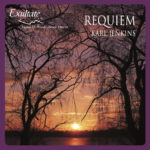Description
Crucifixus and Other Works of Paul Mealor
(Music from the Soul – For the Soul)
This CD is a recording of choral music by Welsh composer, Paul Mealor. It contains his Oratorio Crucifixus as well as these motets and anthems: Locus Iste, Ubi Caritas, Peace, My Song, Blessing & Jubilate Deo. Hear marvelously moving music for your soul.
Audio Samples
Crucifixus
- I. Introit – How Beautiful On the Mountain
- II. Your Silence is the Stillness – Philip Zawisza, baritone
- III. O Sweetest Jesus
- IV. Drop, Drop, Slow Tears
- V. The Tree Takes Living Flame
- VI. Finale – I Tend You in Paradise – Philip Zawisza, baritone
Other Choral Works
- Locus Iste – Kathryn Eakright, soprano; Michael Balzotti, tenor; Brian Haase, bass
- Ubi Caritas
- Peace
- My Song – Betsie Feldkamp, soprano; Russ Carlson, tenor
- Blessing
- Jubilate Deo
Program Notes from the Composer – Crucifixus
Crucifixus
I. My Crucifixus begins with a setting of Isaiah 52:7, How Beautiful on the Mountains are the feet of those who bring good news. Here, Isaiah predicts the birth of the Messiah – he, who would save the people of Israel. The meaning in this passage seems also to suggest this: Isaiah was describing the certain return of the Jews to their own land. He sees in visions the heralds announcing their return to Jerusalem, running on the distant hills, declaring that the long and painful captivity was closed, and that the Holy City and its temple were again to rise with splendor, and that peace and plenty and joy were to be spread over the land. My setting of this vision of hope and rebirth is accompanied by a solo cello singing the advent hymn, O Come, O Come, Emmanuel and ransom captive Israel. This, of course, is in allusion to Isaiah’s prediction that God would give us a sign, and He would be called Emmanuel – God with us. The movement begins and ends with a plainchant, high in the strings, a recomposing of the compline hymn, Te Lucis ante terminum (at the closing of the day) which, suggesting Christ’s destiny and death even at His birth, becomes the harmonic and melodic backbone of the entire work.
II. The Second meditation, Your Silence is Stillness, presents the scene of our Lord on the Cross, injured and silent before the hour of his death. This gentle choral hymn is accompanied by a canon of descending lines, representing the precious blood dropping. The music feels trapped here; ever decreasing, descending lines in the orchestra are detached from the choral part, swamping it at times. One brief pause is given as Christ himself speaks. This is set in Latin and as plainchant accompanied by a solitary bell. Even this, however, cannot stop the relentless march of time.
III. O Sweetest Jesus is a hymn of meditation and devotion, taking its text from the Roman Catholic prayer before a crucifix. For me, this is the most deeply personal part of my settingof the Crucifixus, and one which allows us to join with Christ’s suffering. Amid the anguish of the orchestral accompaniment, a solo violin offers a prayer of hope and light, recalling some of the melodic and harmonic material of the opening movement. Here, the descending lines of the second movement are transformed from fear and hurt to tears of compassion, love and hope as we all weep at the sight of Christ.
IV. Drop, Drop, Slow Tears is a choral interlude which is sung without orchestral accompaniment. It is the emotional heart of the entire work, and sets Phineas Fletcher’s deeply moving poem which tells of the devotional Mary Magdalene as she uses her tears to wet and bathe the feet of Jesus (Luke 7:38). Mary’s great act of love and penitence frees her from her troubled life, and shows us all the beauty of redemption.
V. The Tree Takes Living Flame is an aggressive, tortured response to Christ’s treatment and final moments on the cross. An intense battery of percussion is set alongside virtuosic parts for strings and piano to create a whirlwind of emotion representing the tree (the cross) taking ‘living flame’ (washed with Christ’s blood). The choir also actually becomes ‘flames’ at various points, as some words are set in hocket between male and female voices.
VI. The finale, I Tend You in Paradise, begins with a lament from Christ, “What have I done to you?,” but quickly moves into a long processional that brings all the other movements from the entire work together, leading to a rousing conclusion of Alleluia (Praise God), before the final words from Christ, Consummatum est (it is finished) and the music dissolves upwards. This quiet, gentle resolution brings the Crucifixus to a close.
Crucifixus was commissioned by the Sound Festival and premiered on November 11, 2012. It is dedicated to Professor Derek Ogston C.B.E.
– Paul Mealor
Locus Iste
Paul Mealor composed Locus Iste to celebrate the 500th anniversary of the consecration of King’s College Chapel, a beautiful medieval sanctuary still used for weekly worship at the University of Aberdeen, Scotland.
Ubi Caritas
Prince William and Miss Catherine Middleton asked Mealor to compose a choir piece for their wedding that would offer a moment of meditation and quiet contemplation amongst the pomp of a royal wedding. Mealor responded with Ubi Caritas, a gentle hymn about love and service blending the familiar sixth-century plainchant with 21st century harmony.
Peace
In 1967, Sebastian Temple adapted the beloved Prayer of St. Francis into a congregational hymn. Mealor composed this expansive choral setting of Temple’s adaptation for the wedding of his friends Kirsten Anderson and Raemond Jappy in 2013.
My Song
For this composition, Mealor adapted a haunting poem about a mother’s love written by Rabindranath Tagore, the famed Bengali poet who won the Nobel Prize for Literature in 1913.
Blessing
Two years after the royal wedding of Prince William and Catherine Middleton, Mealor composed a new choral work for a ceremony honoring another member of the royal family. This beautiful setting of a traditional Gaelic blessing was first performed in June 2013 at the installation of Camilla, Her Royal Highness the Duchess of Cornwall, as Chancellor of the University of Aberdeen, the first woman and the only royal ever to hold that post.
Jubilate Deo
Distinguished Concerts International New York commissioned this work and gave its premiere performance at Carnegie Hall in 2016. The text combines the opening verses of Psalm 100 with lyrics by Grahame Davies, the renowned Welsh poet. – Yvonne Grover






Reviews
There are no reviews yet.